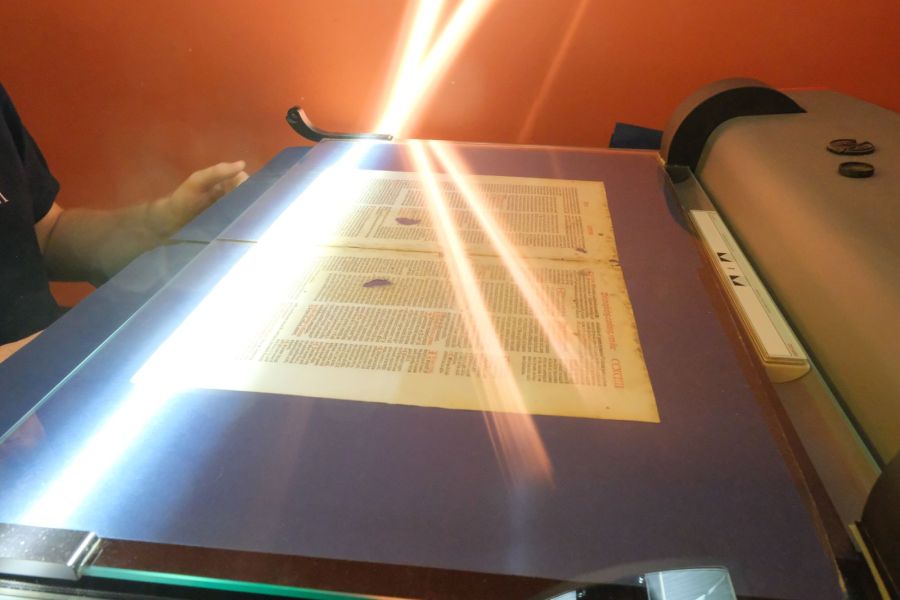The University Library in Poznan has over 3 million volumes in its collection. Not all of them are available only on-site, in the building at Ratajczaka 38/40 in Poznań. Some of them can be found on the... Internet, or more precisely in the Greater Poland Digital Library: https://www.wbc.poznan.pl/.
It is a joint initiative of Poznan's academic community involving scientific and public libraries of the City of Poznan supported by the Poznan Supercomputing and Networking Centre. The premise of the project, ongoing continuously for 20 years, is to create online access to four types of resources: educational (scripts, textbooks and scientific monographs), cultural heritage (selected historical writings), regionalalia (writings on Poznań and Greater Poland) and musicalia (sheet music and writings related to music).
- "It all begins with the selection of materials that we honestly wish to digitise and disseminate, as it is our primary objective," says Jolanta Noskowiak, head of the Resource Protection Division and Digitisation of the University Library in Poznań. "It's a time-consuming process. The materials are often very damaged, and solely, those well-preserved are digitised quickly. Everything depends on the format, too. If the material is prone to tearing or glued together, it can be quite dramatic," continues Jolanta Noskowiak. Frequently, work on a volume has to be paused to enlist the help of the Book Preservation and Restoration.
The team at the Book Preservation and Restoration works on two special scanners for different formats, using cold light to avoid damaging older publications. The BUP's most valuable collections are held in the Special Collections. This is where the selection of volumes that should be digitised is made.
- "The rarest, most valuable and oldest collections are digitised first, along with those most vulnerable to the damaging effects of the passing of time. All objects forming part of the National Library Collection are also digitised," says Rafał Wójcik, PhD, Head of the Special Collections of the University Library. - Currently, as part of the two grants under the Social Responsibility of Science (SON) programme, we are developing and scanning several hundred incunabula, i.e. the oldest prints published between Gutenberg and 1500, and digitising valuable documents of social life, such as flyers, programmes, posters and other ephemeral prints connected with the pre-war history of Adam Mickiewicz University in Poznań. In the coming months, with funds obtained from the Marshal's Office (European Funds for Wielkopolska), the BUP (University Library will be creating a digital platform for the Mirabilium Collectio special collections.
How should an object be digitised? The question is answered by Jakub Łukaszewski, senior librarian at the Old Prints of the Special Collections.
- "In processing, the essential elements of the bibliographic description, such as the author, the title, and the simplified title, should be provided. Then, we determine the publishing address of the given item, date of publication, physical description of the copy, volume, and number of pages numbered and unnumbered. The study also includes information on whether it is a sheet music notation, including illustrations and the type of illustrations."
- "Today, students might listen to this with disbelief, but, I remember queuing for a number in the cloakroom in the 1970s," recalls Dr Artur Jazdon from the Regional Library Resources of the Special Collections. - "The cloakroom gave out numbers to get into the reading room. Twenty years ago, when we began the digitisation process, we also started buying electronic journals. At the time, we told students that they didn't have to come to the Library and that they could read these magazines at home. This backfired on us a bit. However, we need to remember that our primary goal is accessibility for readers, and they, often do not know where the Library is physically located anymore," concludes Dr Artur Jazdon.
The Wielkopolska Digital Library contains nearly 3,900 titles and nearly 8,000 volumes, collected in almost 2.5 million files, covering over 52 terabytes of data. In addition, thanks to the tremendous work of, among others, the University Library employees, it is growing all the time.
Photo: Przemysław Stanula










